I figured I’d take a little bit of a detour today, just for shiggles. Rather than talk about finance or do another stock analysis, I wanted to show you all my carnivorous plants collection. Yep, I grow Venus fly traps, sundews, and pitcher plants as a hobby! I’ve been growing them on and off over the past few years, but only really began to take it seriously in the past year. From my humble beginnings attempting to grow those poor half-dead Venus fly traps you see in the garden section of Home Depot, I have a thriving collection of nine plants. So let’s take a look of what I am currently growing!
Note: Click the pictures to see a bigger version.
Pygmy Sundews:
So these lovely plants are pygmy sundews. Bought these guys at the suggestion of my lovely girlfriend, because hey, they’re really cute. Pygmy sundews are, as the name suggests, really tiny plants, each sundew is only about the size of a US nickel. My drosera patens is even smaller, about the size of a US dime! They’re natives of Western Australia, and eat small insects. I keep them in a terrarium, just plop the pots in there, and pour about an inch of water in there to keep them most and humid. Since they require a lot of heat and humidity, I normally keep them outside on my balcony. But it is getting kind of cold out, so I moved them inside, next to the patio door. That way they get the sunlight they need, but the low (mid 50s Fahrenheit) temperatures don’t kill them. May have kept them outside a bit too long, the drosera pulchelia and drosera patens appear to be dying ![]() Hope I can make them recover soon!
Hope I can make them recover soon!
Feeding these little guys is tough; they’re too small to eat anything larger than a fruit fly, and those get eaten by a bigger plant. So I feed them with crushed betta fish pellets mixed with distilled water, administered by pipette once a month. Seems to be working nicely so far.
You may have noticed that some sundews have long strands growing out of them. Yep, those are flowers! Those are even smaller than the plants themselves. Each flower is only about an 1/8 of an inch in diameter. Cool thing is, they open in the morning, when the sun rises, and close at dusk. The flowers aren’t involved with reproduction, as pygmy sundews actually grow asexually via gemmae.
Sundews:
This is another sundew, albeit a normal-sized one. Nightmare is a native of New Jersey, and is actually growing really well. It’s a temperate sundew, and can actually handle lower temperatures than the pygmies. Yet, I brought it inside anyway because it shouldn’t be kept too cold for too long. This thing loves to eat fruit flies, which is a godsend sometimes. I just pop it on the counter in my kitchen when I go to sleep. Next morning, no more fruit flies, and Nightmare’s leaves are happily curled around its dinner. A funny thing I noticed is that it produces a lot of dew. Like, dripping-off-the-leaves a lot. Definitely means it’s healthy, but can be a pain to feed because the food will get stuck somewhere not on the leaf itself. And the flowers it puts up often die because the stalk gets caught on the dew instead of growing straight up. I have to keep an eye on it because of that. It’s in the same terrarium as the pygmies, so humidity and watering aren’t an issue.
Fun fact, some sundews can live up to 50 years!
Venus Fly Traps:
Ah yes, no carnivorous plant collection would be complete without a Venus fly trap! Gremlin is a fun little plant, named because it grows extremely quickly. In the month or so I’ve owned it, it’s approximately doubled in size. Almost a dozen new traps are growing! Gremlin is actually pretty adept at catching its own food, and particularly likes ladybugs and house flies. The traps close quickly, in sub-one second. They require a lot of humidity, so I spray them with distilled water twice a day, and keep them in a full water tray. I didn’t know that they require so much humidity; I wonder if that’s why my old ones never survived very long? Another interesting fact I didn’t know until recently is that they require a dormant period in winter. In order to remain healthy, they need to be ‘put to sleep’ via cold temperatures from about November 1st to Valentine’s Day (roughly). Thus, I’m keeping them outside until the temperature outside gets to the 30s, then I’ll put them into dormancy in my fridge. They apparently will live a few years without dormancy, but it’s not worth losing the plant to keep it ‘pretty’ year round, you know?
Fun fact: Thomas Jefferson loved these plants and once (unsuccessfully) tried to grow them at Monticello.
Pitcher Plants:
There are two familiers of pitcher plants out there, the American Sarrcaenia and the Asian Nepenthes. I own both. Unfortunately, I can’t really say much about my two Sarracenia, Judith Hindle and Dana’s Delight, since they were both going into dormancy when I got them. Hopefully I’ll get to know them in the spring.
The crown jewel of my collection is my Nepenthes. Honestly, I don’t know what species it is, since I bought it off Amazon and the seller didn’t clarify [UPDATE 10/11/2014: I checked with the seller, and it’s a hybrid of some sort. We suspect it’s a N. alata x ventricosa, but neither of us are sure]. Yet it is growing extremely well. Nepenthes is actually a vine, and I actually need to trim it from time to time to ensure that it stays a manageable size. It’s pitchering profusely, which is great, since the big ones are dying off because of age. Since it is a temperate plant, it needs a relatively consistent temperature, so I’ll be bringing it inside very soon. I also spray it a lot to keep the humidity up.
Funny thing is, I never knew I had a hornet’s nest outside near my patio until I left it outside. I was just checking the pitchers one day and saw about two dozen hornets inside them all! Heh, it’s probably my favorite plant because of that alone. Some insects like it; there’s a spider who’s made his home in one of the pitchers. So many small flies are attracted to the nectar, the spider decided to set up shop in one and eat heartily non-stop! I’m sure my plant can spare a few insects, based on how well it eats … In the winter, I’ll hang it in my kitchen, so it can eat any small insects that are making their way inside. I’ll supplement its diet with betta fish pellets once a month for safety.
Fun fact: Nepenthes are also known as ‘monkey cups‘, because in the wild, monkeys love to drink the liquid stored in the pitchers. Certain Nepenthes, including Nepenthes Rajah, can eat poop and hold almost a gallon of liquid per pitcher!
So that’s my carnivorous plants collection as of now! Hope you enjoyed the look!
Have you ever grown carnivorous plants? Have any questions I can answer? What interesting hobbies do you have?
Images are all (c) 2014, DividendDeveloper.com.
13 Comments

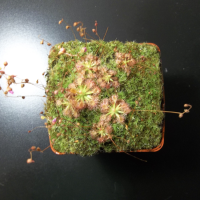
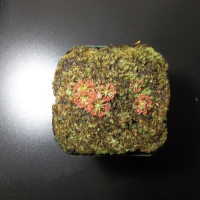

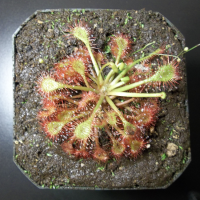
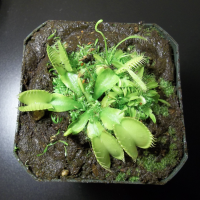
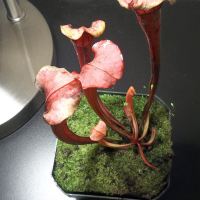
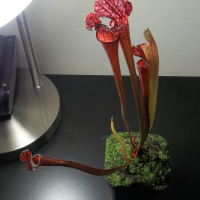

Ahah I love the post. I used to read a lot of books about carnivorous plants a couple of years ago and almost bought one.
Are you really feeding your plants with beta food? Great idea! At least it’s better than to raise fruit flies in your house.
That’s what I like about this community of dividend growth bloggers. Everybody has passions and they are not seeking to be “rich” just to become rich, but because they want to own their time to dedicate themselves to their true passions would it be writing or feeding carnivorous plants with beta food
Cheers
Allan recently posted…Save! The best homemade pizza recipe ever!
Glad you liked it, Allan! It’s a really fun hobby at times, but a lot more difficult than I originally expected. Yep, betta fish food works for me! Heh, I tried using real insects, but that didn’t turn out well. Mealworms were easy enough, but a) they’re actually too fatty to be healthy for most carnivorous plants (my Nepenthes couldn’t eat them at all) and b) they’re known to actually eat through the plant and escape! Crickets were … just no. And you can’t fertilize them because fertilizer is so strong, it destroys their roots completely and kills them. Not like it matters anyway, since they’ve adapted to truly terrible, nutrient-poor soil. So yep, once they’re inside, give them some pellets once a month, and they’re content!
I didn’t realize how little I knew about carnivorous plants until now. I always figured they preferred tropical climates and it never crossed my mind that feeding them could be an issue. But I guess its really the same idea as taking care of any other plant, just a different form. I should do some research on those sundews, my mom sells fruit during the summer so she always gets swarmed by fruit flies, a sundew would be in heaven!
Yeah, they’re much more complicated to grow than I realized. Humidity, water, feeding; I used to just think putting it on the windowsill and letting it be was good enough. I highly recommend getting one! Nightmare’s a good plant, and I recommend it for sure. Not too difficult to care for, and they’ll love your fruit flies. That, or a small Nepenthes would be good for you, since they don’t require dormancy.
DD,
nice plant collection! Being a committed investor that I am, I like the fast growing venus fly trap the most.
Wish my portfolio would match the pace.
Thanks for the fun I had reading your detour.
Grow Independent recently posted…Why I Won’t Fail At Transitioning
Hahaha, I can see why. The thing grows like a weed. May our portfolios do the same!
Wow! I work at a science museum and yet never seen any of these although those curators talks about these a lot.
Happy FI recently posted…Expenses And Saving Update: September 2014
Glad to have broadened your horizons a bit then! Thanks for stopping by!
Pingback: Great posts about personal finance to read this week-end! - Quit Your Day Job 101
This is really, really cool. I remember a friend who had a venus fly trap plant when we were like 8 and I remember catching mozzies and feeding them to the plants – so cool!
I think you might have started the process of me getting some of these… we have little fruit flies that come in every now and then so if we had a plant that ate them…. huzzah!
Steve recently posted…36 Successful Bloggers Reveal Their Investing Styles
Ha, glad you liked it! I’d prefer my Nepenthes for that. Sundews are also good, but a bit trickier to care for. Just make sure you keep the humidity and light levels up.
Great post!
It’s aways interesting seeing how other DGIs spend their time (aside from investing) as we’re a quirky bunch.
The Pitcher Plants were the most recognizable for me and I’ve been considering getting a plant for some time now. As a result of reading this, I might just make it a carnivorous one!
What sort would you recommend for a beginner (I’ve never owned plants before).
– Ryan from GRB
Get Rich Brothers recently posted…Trade Less and Make More
Hey Ryan, thanks for stopping by! Yeah, that’s why I love the community; we have so many diverse and interesting hobbies. I’d highly recommend getting one! As to which one, kind of depends on your location – is it humid, does it get cold? You’ll need somewhere with good lighting, and keeping it outside is a good thing. Distilled water or rainwater is a must for watering/misting; most tap water will kill it. Venus fly traps and Sarracenia both require dormancy periods, which are tough. This is actually my first winter with them, and I’m not sure I can pull it off myself. Pygmy sundews are tough; I’m having trouble keeping them very healthy. Can’t say much about bladderworts and others since I haven’t tried to grow them yet. I personally think sundews in general are harder to care for in terms of feeding. That leaves Nepenthes, the Asian pitcher plant. I love mine since it’s very hardy and grows like a weed. Some good beginner species are N. alata, N. ventricosa, and N. truncata. Generally, highland Nepenthes are a bit easier because they’re more lenient in their weather requirements. Hope that helps; if you have any specific questions, or want to bounce plant ideas off of me, feel free to drop me an email!